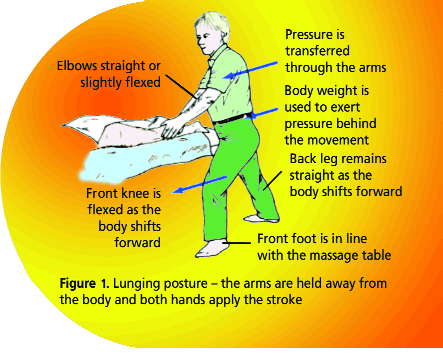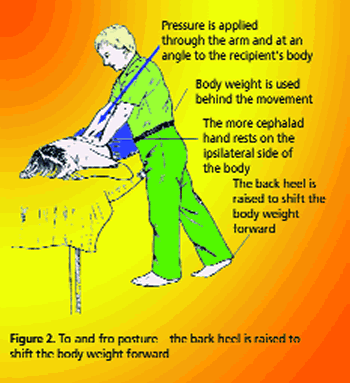Positive Health Online
Your Country

The Importance of Good Posture in Bodywork Part I
by Mario-Paul Cassar(more info)
listed in bodywork, originally published in issue 109 - March 2005
In my previous articles I have discussed the need for a high standard of treatment in massage and bodywork and the relevance of thorough case histories, assessment procedures and palpatory skills. Another factor which is of great significance to the treatment, and which I am considering in this issue and the next, is the practitioner's own posture (the position of the body as well as the hands) during the treatment.
It is a common mistake to assume that an adequate massage or bodywork treatment requires the therapist to apply hard, strong and heavy strokes, or that powerful hands and considerable body strength are necessary. The most crucial aspect of a massage or bodywork treatment is that techniques used are not only effective but can be applied with the minimum of effort. Accordingly, the therapist's stance plays a very central role because his or her standing posture in relation to the treatment table and to the patient influences the efficacy and flow of the technique.
Postural awareness is a combination of body position, body weight and direction of pressure. These components can be adapted to suit the therapist's own structure, the height and width of the treatment table and the therapist's own preferred massage methods. The therapist's body weight is used to apply pressure to the massage movement. To this end, adjustments in the posture are made before each movement so that a comfortable and practical stance is taken.
This position should enable the therapist to shift the body weight backwards and forwards, or from side to side. It should also allow for a coordinated action between the body and the hands during the massage movement. A good posture is, therefore, one in which the therapist feels well-grounded, whilst having the freedom to move.
Two examples of postures that can be used for various massage and bodywork techniques are described here. These are designed to provide basic guidance and can therefore be adapted to suit the individual.
Lunging Posture (Figure 1)

This posture facilitates long massage strokes, for instance along the length of the patient's lower limb, without any forward bending of the trunk. It can be described as a mid-upright position, with the legs set apart as in the `lunging' pose of fencing. The front foot is in line with the treatment table whilst the back foot is rotated laterally. Another adjustment is for the practitioner to be in a position slightly away from the treatment table or leaning against it, depending on the massage movement being applied. When the front knee is flexed, the body moves forward and the weight is shifted to the front foot. As the knee extends and straightens, the body moves backward and the weight is shifted to the back foot. During the forward movement the back leg remains locked straight; as the body moves backward it can flex at the knee or remain in the same position. The back is more or less upright throughout the movement. In this posture, the pressure is applied through the arms and onto the hands. The arms are either straight or slightly flexed at the elbow.
To-and-Fro Psture (Figure 2)

For the to-and-fro posture, the therapist stands away from the treatment table with the feet placed one behind the other. The position of the feet is determined by how much weight is necessary for the massage movement, and by what is a comfortable position for the therapist. Having the feet farther apart allows for more body weight to be transferred through the arms. Body movement in this posture is forwards and backwards (to-and-fro). Forward movement is performed as the body weight is shifted onto the front foot. At the same time, the heel of the back foot is raised slightly in order to elevate the body and alter its centre of gravity. As a result the body tilts forward, which exerts pressure through one or both arms. Raising the heel adds more body weight to the movement. In order to accomplish this transference of weight, the arms are held in a straight position or flexed slightly at the elbow. Although the back is more or less straight, some forward bending is inevitable; this should, however, be kept to a minimum. Pressure through the arms is released as the body shifts backward, and the heel of the back foot is lowered to the floor. The to-and-fro posture is used to apply strokes to the contralateral side of the body, or from the head end of the massage treatment couch.
Adopting and maintaining the correct posture during a treatment is of great benefit to the therapist. The direction, pressure and rhythm of the movement are easily controlled. Furthermore, very little energy is needed to carry out the technique whilst mechanical stress on the therapist's own body is avoided. Ease of movement means that the therapist's own body and hands are relaxed, and this relaxed state can be transmitted to the patient.
Comments:
-
No Article Comments available